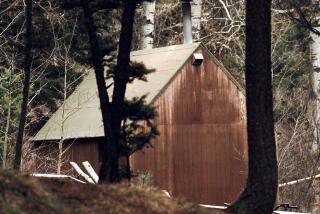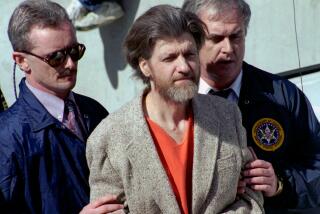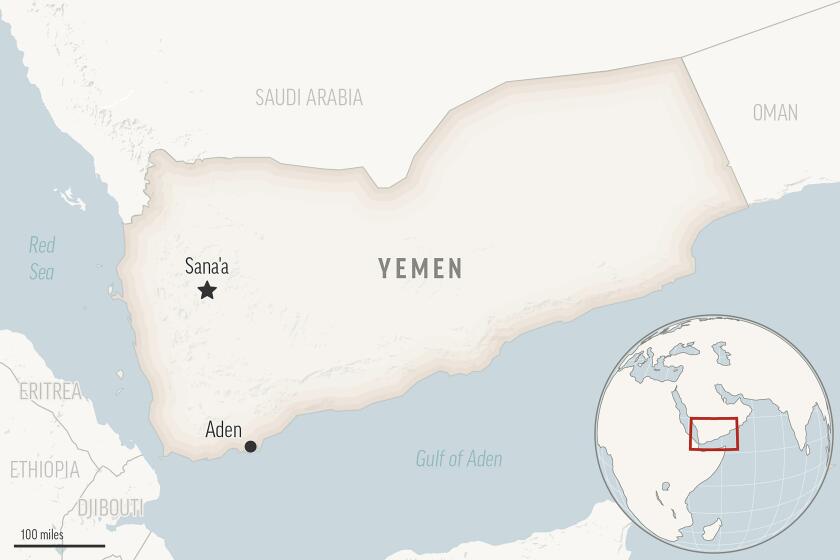2nd Bomb Found in Suspect’s Cabin
- Share via
LINCOLN, Mont. — Federal agents discovered a new, unexploded bomb as they X-rayed about 40 boxes of materials at the ramshackle cabin of suspected Unabomber Theodore J. Kaczynski on Saturday, officials familiar with the investigation said.
The finding, more significant than the partially constructed pipe bomb and other bomb-making materials found there last week, gives investigators new evidence to compare with the Unabomber’s methods of operation as they have evolved over the past 17 years, the officials said.
It also adds to their growing conviction, after earlier tests found a preliminary match between the Unabomber’s texts and a manual typewriter found at Kaczynski’s cabin, that the thin, unkempt hermit who lived in this Rocky Mountain outback is indeed the bomber responsible for at least three deaths and 23 injuries.
The latest bomb was safely defused, but it underscored the danger of the search as agents make achingly slow progress through the dim and cramped cabin. The wooded property around the structure was opened to the media for a brief viewing for the first time Saturday afternoon.
Fearful of setting off a booby-trap or another unexploded bomb, agents were said to be using water jets to open some of the most suspicious-looking boxes at the site. About 40 boxes of material, found in a loft of the 10-by-12-foot cabin owned by the former mathematics professor, were being combed through over the weekend.
Meanwhile, other federal agents fanned out from the home in this mountain resort town, attempting to piece together if Kaczynski, who apparently had little money and no car, could have traveled as far as San Francisco, from where the Unabomber mailed some of his bombs and letters.
Agents suspect that the Unabomber, whose anti-technology views led him to target airlines, may have traveled by bus.
Bob Pankratz, agent for the Trailways bus line in nearby Helena, told FBI investigators that Kaczynski looked familiar. But there are no records of bus passengers, and Pankratz said in an interview he could not recall for sure whether Kaczynski had ridden the bus.
“I’m sure that I did [see Kaczynski],” Pankratz said. “He’s familiar, but I don’t know when he traveled or where he traveled.”
Dick Lundberg, a mail carrier who befriended Kaczynski, said he took him into Helena at least six times a year. He said he would always drop him off at the Park Hotel, a $14-a-night lodging in downtown Helena’s Last Chance Gulch.
Usually, Lundberg said, Kaczynski would stay overnight and ride back with him the next day. “If he stayed three or four days, he rode up with somebody else,” Lundberg said.
Park Hotel owner Jack McCabe turned over to the FBI hotel records showing that Kaczynski registered as a guest at least 25 times in 1982 to 1995, the key years for which they were seeking information. Four of those stays were within three weeks of Unabomber attacks.
When Kaczynski first started coming in, McCabe said, “he was clean-shaven and had a short haircut. He wore work clothes, like he’d been on the ranch, or a farmer. Very quiet, very polite.”
But during the last year, he said, Kaczynski had become much more unkempt. His beard grew longer and scraggly, and his hair was uncombed. “If a stranger came up with that appearance, I probably wouldn’t have rented to him,” McCabe said.
He said that Kaczynski usually carried only a small canvas shoulder bag and would go in and out several times during the day, including trips to a nearby secondhand bookstore. He would bring in a deli sandwich and bottled juice or water for dinner. He would usually leave the next day, McCabe said.
“He was always non-talkative. I couldn’t even get him to talk about the weather,” he said. “I just figured he had some ranch up in Lincoln and he was coming to town to buy a few things he couldn’t get up there.”
Lundberg also could provide another important link in the investigation: the question of how Kaczynski could have financed wide-ranging travels when his only means of support appeared to be his garden and local wildlife. The local lumber mill operator said that he gave Kaczynski a job 10 years ago peeling bark off logs, but Kaczynski quit the first day.
In an interview Saturday, the mail carrier said he delivered about half a dozen personal letters to Kaczynski every year, including at least one from what appeared to be a family member. It came on printed letterhead bearing the Kaczynski name, he said.
Government sources confirmed that Kaczynski was sent money by his mother, Wanda, who now lives in Schenectady, N.Y. They said she provided investigators with her canceled checks, which had been cashed at banks in Montana.
The primitive cabin where Kaczynski has lived at least periodically since 1971 has been shrouded in secrecy since federal agents swept in for their search on Wednesday. But authorities allowed reporters a firsthand view Saturday of the hilly, wooded retreat below Baldy Mountain.
Although the FBI prohibited access to the interior, a troupe of journalists was escorted by Jim R. Freeman, head of the FBI’s “Unabom” task force, through the 1.4-acre property and around the plywood-and-tar-paper cabin that lies in a tranquil gulch about 300 yards from the nearest house.
The weathered brown cabin has two small windows, one each on the north and south sides. The cabin is about 15 feet tall and has a small loft.
It also has a solid wood door with three locks--two of them set into the door, and a third hasp and padlock.
There is no outhouse, running water or electricity. A creek about 75 yards away apparently serves as a source of drinking water.
There is a board propped between two trees with a five-gallon bucket on top, which appears to be a makeshift shower. Nearby are several bleach bottles that Kaczynski may have used for hauling water or watering two garden plots.
A young tree stands in the yard, protected from deer by a circle of fencing.
From the house, a path leads to a fire ring, where Kaczynski apparently lighted campfires.
Near the house are an old root cellar and a drying shed, which measures about 6 feet square. Inside the shed are two bicycles: a broken-down green bike and the red bike with raised handlebars that Kaczynski was frequently seen riding down the four-mile dirt road into downtown Lincoln.
About a dozen federal agents stood on the property during the tour, and two rings of crime scene tape, one close to the cabin and one farther away, circled the site where the FBI has been searching.
Bright lights have been set up alongside cardboard boxes and an equipment locker, and a U-Haul truck that will be used to take evidence from the scene is parked down the road.
FBI officials in Lincoln have refused to discuss any aspect of the case or the search of Kaczynski’s cabin, which is expected to continue at least until midweek.
Kaczynski’s family, shielded from a barrage of reporters at their home in Schenectady, have declined to talk about the case, although a lawyer representing the family, Tony Bisceglie, said Saturday he would issue a statement on Monday.
Bisceglie represented Kaczynski’s brother, David, in a long, emotional series of negotiations with the FBI that led to the family’s agreement to allow federal agents to search their former home near Chicago. It was in that home that old letters from Theodore Kaczynski which appear similar to the Unabomber’s writings were located.
Paddock and Murphy reported from Lincoln, and Ostrow reported from Washington, D.C.
More to Read
Sign up for Essential California
The most important California stories and recommendations in your inbox every morning.
You may occasionally receive promotional content from the Los Angeles Times.













